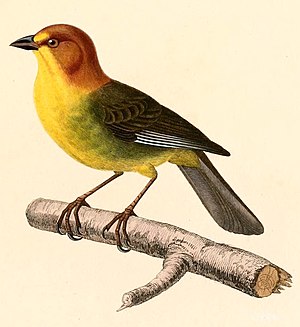Brown Beard Bushhammer
| Brown Beard Bushhammer | ||||||||||||
|---|---|---|---|---|---|---|---|---|---|---|---|---|

Brown Beard Bushhammer ( Atlapetes fulviceps ) |
||||||||||||
| Systematics | ||||||||||||
|
||||||||||||
| Scientific name | ||||||||||||
| Atlapetes fulviceps | ||||||||||||
| ( d'Orbigny & Lafresnaye , 1837) |
The brown beard bushhammer ( Atlapetes fulviceps ) is a species of bird from the family of the New World chambers (Passerellidae). The range of the species is limited to the countries Argentina and Bolivia . The IUCN assesses the population as Least Concern .
features
The brown beard bushhammer reaches a body length of about 15 centimeters. The head side, the crown and the nape are reddish brown. The back, wings, and tiered tail are dark olive. The color of the yellow rein and beard line stand out clearly from this. The line under the cheeks is reddish brown in the female and blackish in color in the male. The yellow underside has olive tones on the chest and sides.
distribution and habitat
They move in semi-humid zones in the stratification layers from the ground to around 3 meter high bushes and trees at heights between 1850 and 3150 meters. In winter they migrate to lower elevations of up to 400 meters. They prefer open terrain with secondary vegetation and groups of trees in wooded valleys. They are often seen near running water. Every now and then they climb up into the Polylepis forests. Its distribution area extends in Bolivia to the departments of La Paz , Cochabamba , the west of Santa Cruz , Chuquisaca and Tarija . According to censuses by BirdLife International , they were recorded in the Cordillera de Sama Biological Reserve , the Tariquía National Fauna and Flora Conservation Area, and the Tunari National Park . In Argentina they occur in the northwest in the provinces of Jujuy , Salta and Tucumán .
behavior
You see the brown beard bushhammer mostly in pairs. They look for seeds and insects in dense undergrowth, on moss-covered trunks or thick branches. Sometimes they climb around upside down. You may see them on the ground, but this is rare. As soon as they sense danger, twitch their tail and chirp an alarming pi ziue . Otherwise their singing is a repeating thin zit . In Jujuy they breed in January.
Research history and etymology
D'Orbigny and Lafresnaye used the taxon Emberiza fulviceps in their first description . Only later was the bird categorized in the genus Atlapetes . The word Atlapetes for the genus is made up of atla for the Titan Atlas , whose name means bearer, patient and petes from the Greek petros for rock . In ancient mythology, Atlas carried the vault of heaven on his shoulders. The specific epithet fulviceps is derived from the Latin word fulvous for yellow-brown .
literature
- Jon Fjeldså , Niels Krabbe : Birds of the High Andes: A Manual to the Birds of the Temperate Zone of the Andes and Patagonia, South America , Zoological Museum and Apollo Books, p. 674, ISBN 978-8788757163
- Robert S. Ridgely , Guy Tudor: Field Guide to the Songbirds of South America. The Passerines. University of Texas Press, 2009, ISBN 978-0292719798 , p. 647.
- Robert S. Ridgely, Guy Tudor, William Liddle Brown: The Birds of South America Vol. I. The Oscine Passerines: Jays and Swallows, Wrens, Thrushes, and Allies, Vireos and Wood-Warblers, Tanagers, Icterids, and Finches. University of Texas Press, 1989, p. 431, ISBN 9780292707566
Web links
- Atlapetes fulviceps inthe IUCN Red List of Threatened Species 2011.2. Listed by: BirdLife International, 2009. Retrieved January 10, 2012.
- BirdLife International: Species Factsheet - Fulvous-headed Brush-finch ( Atlapetes fulviceps ) . Retrieved January 10, 2012.
- Videos, photos and sound recordings of Fulvous-headed Brush-finch (Atlapetes fulviceps) in the Internet Bird Collection
- Brown beard bushhammer ( Atlapetes fulviceps ) at Avibase; Retrieved January 10, 2012.
- Atlapetes fulviceps in the Integrated Taxonomic Information System (ITIS). Retrieved January 10, 2012.
- xeno-canto: Sound recordings - Fulvous-headed Brush-finch ( Atlapetes fulviceps )
- Antpitta Fulvous-headed Brush-Finch Atlapetes fulviceps image
- Flickr Arañero cabeza detatuca castaña (Atlapetes fulviceps) image
- Pbase Fulvous-headed Brush-finch images
- Mangoverde Fulvous-headed Brush-Finch Atlapetes fulviceps information
Individual evidence
- ↑ IBA Factsheet BO021 Reserva Biológica Cordillera de Sama (Engl.)
- ↑ IBA Factsheet BO042 Reserva Nacional de Flora y Fauna Tariquía (Eng.)
- ↑ IBA Factsheet BO023 Vertiente Sur del Parque Nacional Tunari (Eng.)